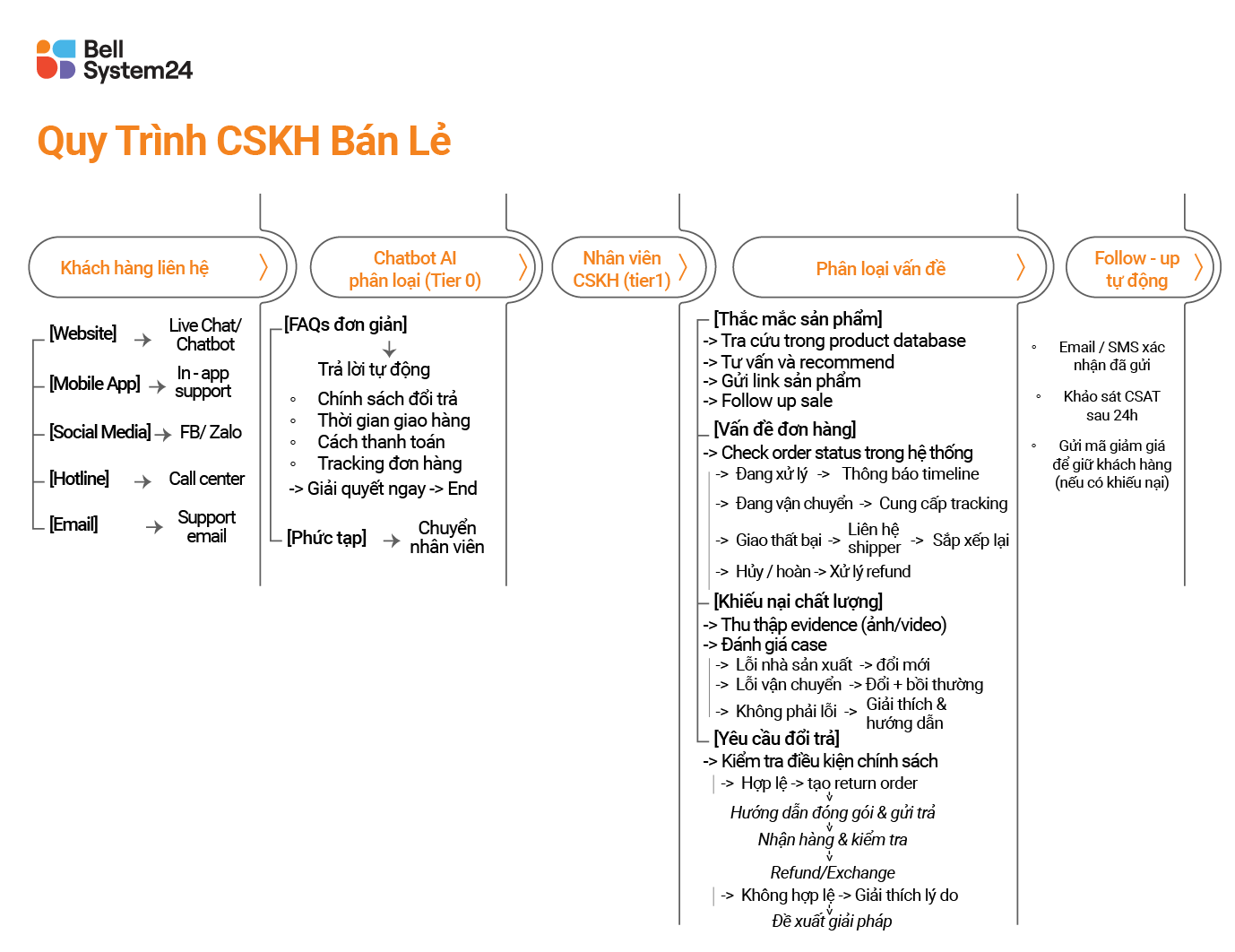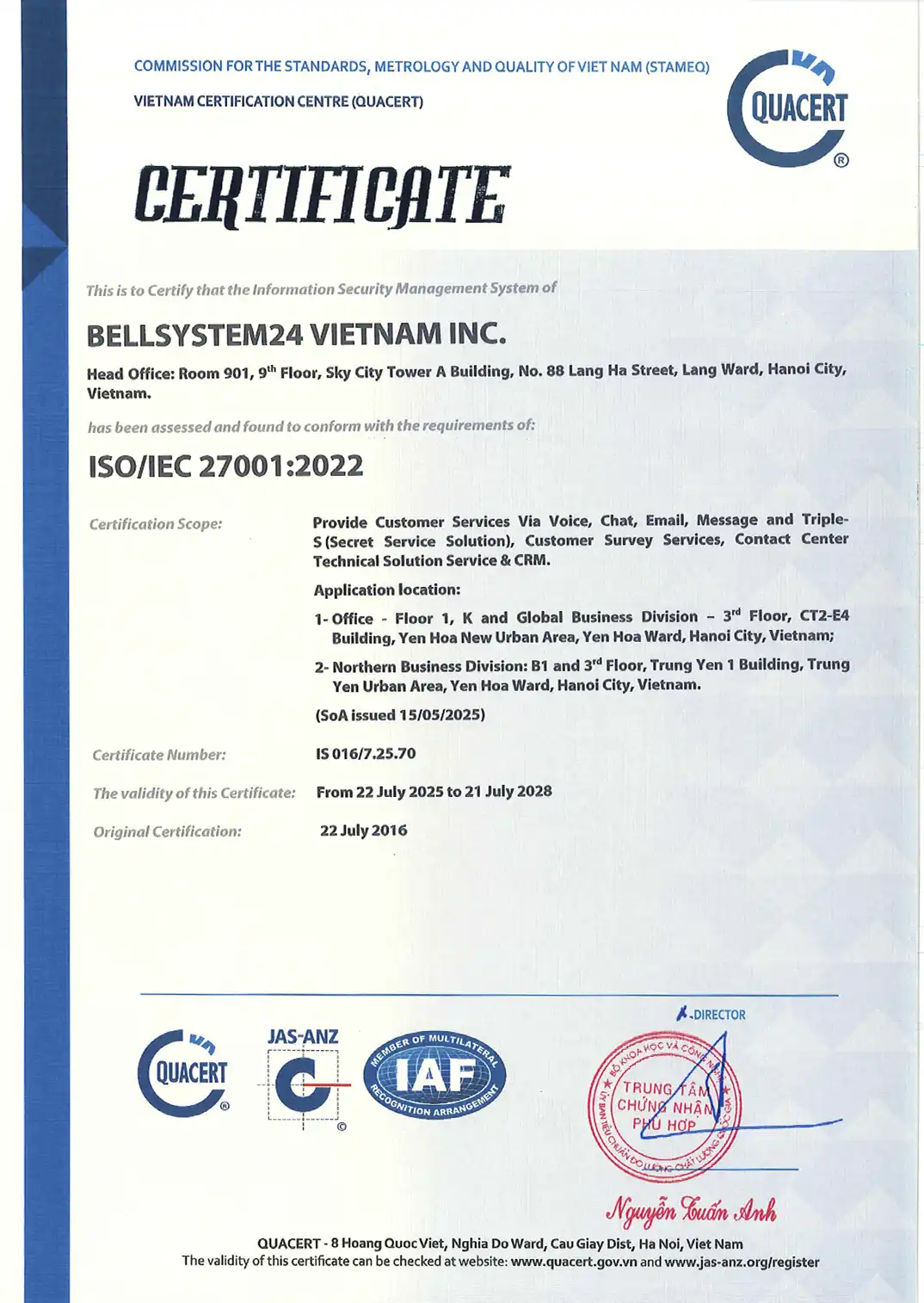
What is Contact Center?
A Contact Center is a call center that can simultaneously receive and handle a large volume of contacts through multiple channels: Voice calls, Chat, Email, App, OTT, etc.
Contact centers are used in businesses to perform customer care, sales, and marketing tasks.
How is the Contact Center call center used?
Currently, Contact Centers are used in a number of business activities such as
Contact center software consists of 2 main components
Interactive modules
- Includes call, livechat, email, video call features (Each module connects to other business software via API)
- Gather all customer interactions across channels and organize them by history. Help deploy customer service, sales, and marketing tasks in a synchronous and seamless manner.
- In addition, contact center software can also be customized with many additional functions to enhance customer experience when interacting such as: Chatbot, Autocall, Automatic Voice Response (IVR), ACD, Voice biometric.
CRM (Customer Relationship Management)
- CRM is where customer information is stored throughout the interaction process.
- Each business will have its own requirements for Contact center features. To optimize, businesses need to build a specialized CRM system, tailored to business processes and integrated with the contact center.
To operate the switchboard, you need to have
- Call center staff: Direct interaction with customers.
- Contact center software.
- Server system, network connection.
How are Contact Centers and Call Centers similar and different?
These are two types of switchboards that many people still confuse because both are used for relatively similar purposes.
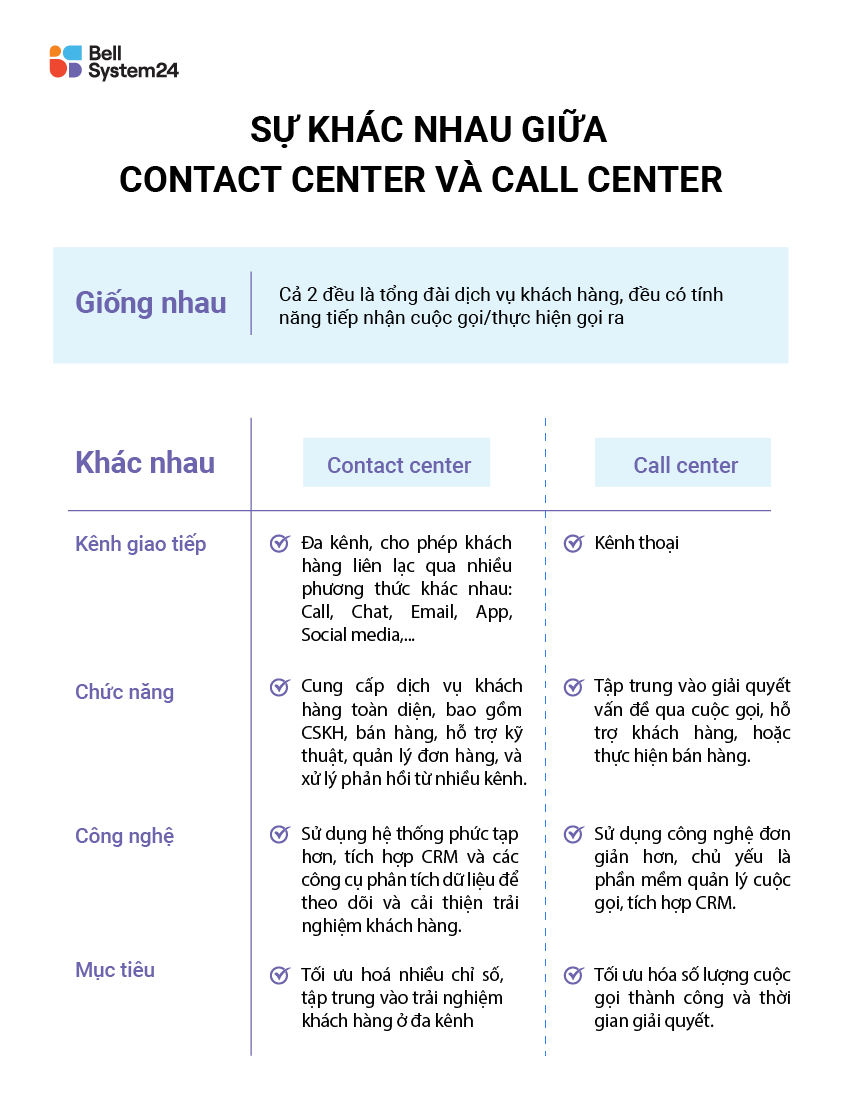
In short, Contact Center is an upgraded version compared to Call Center, providing a more comprehensive experience.
With the rapid development of the Internet, customer interaction needs are no longer limited to voice channels. Instead, customers increasingly prefer to communicate via social media, OTT, and websites. Contact Centers were created to meet the demand for unified multi-channel interaction (Omni Channel).
Learn more: International standard multi-channel Contact Center.
Features that a Contact Center must have!
- Popup: Display available customer information.
- ACD (Automatic Contact Distribution): This is a pre-programmed system to intelligently route incoming calls, ACD helps customers contact the most appropriate operator to answer their questions and complaints.
- IVR (Interactive Voice Response): A pre-recorded voice that guides customers to perform a certain action by following a command (usually a phone key). Example of IVR: Press 1 if you have questions about your account, press 2 if you want to consult other information. IVR helps reduce the time agents have to interact with customers to extract information.
- Email, Chat Management / Response: Collect, classify and respond to emails and chats via communication channels
- Team management and reporting: The system helps plan employee management and report performance, depending on each business there will be a different reporting system.
- Flexible integration via API: Flexible connectivity with other software and devices.
Advanced Features
- Omnichannel: Integrated multi-channel, helps manage interactions along the customer journey in a synchronous and unified manner according to interaction history across multiple channels.
- Chatbot: Bot automatically interacts with customers according to a script.
Build a contact center
Steps to build a complete contact center.

1. Identify needs and objectives
Identify specific needs and objectives: Customer service, sales, cost optimization, etc.
Call center type:
- Inbound: Receiving customer calls
- Outbound: Outgoing calls
- Hybrid: combining both
Scale: Calculate the number of employees and infrastructure needed to handle the interaction volume.
2. Budget allocation
Determine the costs of building and maintaining the switchboard, including:
- Infrastructure: Rent office space, desks, chairs, etc.
- Hardware: Computers, phones, headphones, servers, and other connected devices.
- Software: Software development or licensing fees (typically including: Call center software, CRM, other supporting software)
- Staff: Salary, insurance, other benefits, etc.
- Operating costs: Electricity, water, internet, phone bills, maintenance fees.
3. Prepare technical infrastructure
- Infrastructure: Location, tables, chairs, etc.
- Hardware: Computers, phones, headphones, servers, and other connected devices.
- Software: Software development or licensing fees (typically including: Call center software, CRM, other supporting software)
4. Human Resources Plan
Depending on the call center's objectives, the structure and scale of personnel vary. Many call centers estimate the number of personnel based on (1) call volume, (2) Average call handling time.
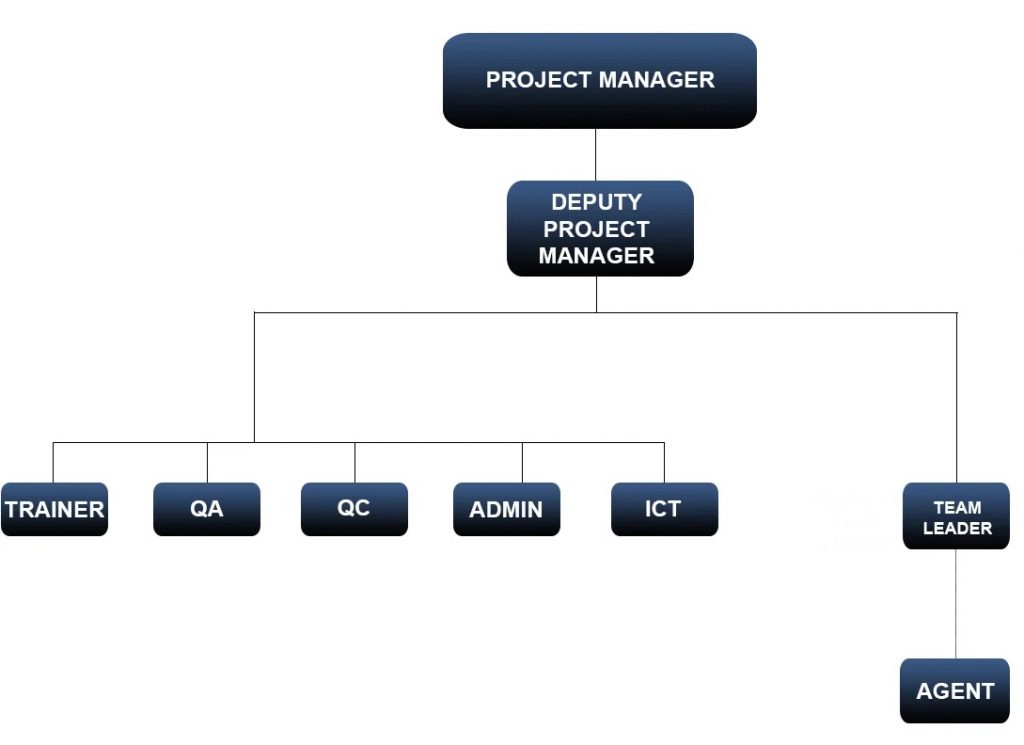
5. Operating procedures
- Develop a call handling process
- Processes, evaluation standards, and performance reports.
- Call script: Standardize the content of exchanges.
- Contingency plans in case of an incident: Reconnect, resolve customer complaints.
6. Recruitment and Training Plan
Based on the objectives and call center operations, develop a recruitment and training plan.
Recruitment
- Determine the number and roles of employees and plan recruitment.
- Develop job descriptions and recruitment criteria.
Train
- Training program on knowledge, professional skills, and entry-level skills.
- Monitoring and post-training evaluation.
- Retraining and advanced training during employment.
7. Call center monitoring and optimization plan
Businesses can measure Call Center performance through KPIs proposed. The evaluation criteria will differ between the Customer Care Center and Sales.
Call centers implemented through outsourcing will measure their operational effectiveness based on:
- Cost per call
- Revenue & Profit Achieved
- Number of completed calls
- Customer waiting time
- Missed call
- Time for discussion, etc.
8. Legal compliance and security
Develop legal compliance and data security regulations for the government and relevant parties.
Some effective solutions:
- Develop work processes and information security in accordance with ISO 27001 standards.
- Secure user information using tools (mask phone numbers, emails, etc.).
- Access permissions based on device or employee level.
- Obtain the customer's 'consent' to make advertising calls (in accordance with Decree 91/2020/NĐ-CP of the government).
Some commonly used terms in Contact Center
Terminology regarding operational procedures.
- Outsource: Call center outsourcing. The lessee will hand over the setup and full operation to a specialized unit and will pay the cost according to the contract agreement. The lessee will make specific requirements and monitor the quality of operations.
- Source: It is also an outsourcing activity but the staff will sit at the lessee's office for convenience in management and supervision.
Human resources terminology.
- Agent: Telephone operator.
- Project Manager: Contact Center Project Management.
- DS (Direct sales): Direct sales staff.
- QA (Quality Assurance): Quality assurance personnel.
- TL (TeamLeader): Team Leader.
Terminology regarding operating procedures.
- Inbound: Receive contacts from external channels into the Contact Center.
- Outbound: Proactively contact customers.
- Self-Service: The form in which customers contact the switchboard but will answer the information themselves without relying on the interaction of the switchboard operator.
- Telesale: Telemarketing.
- Telemarketing: Telemarketing.
- Telesurvey: Telephone survey
- Debt Collection: Debt Collection
System terms.
- PBX: Internal switchboard, helps connect voice channels of employees in the business with each other without any cost.
- VoIP: The telephone switchboard is programmed and operates on the Internet platform.
- Routing: Call routing.
- Recording: Call recording.
- AQM (Advance quality management): Manage and control the quality of interactions.
- ACD (Auto Contact Distribution): Automatic call distribution system.
- IVR (Interactive Voice Response): Automatic voice interaction.
Contact Center Management Terms.
- SLA (Service-Level Agreement): Service quality commitment agreement between the lessee and the service provider
- CSAT (Customer Satisfaction Score): Customer satisfaction index.
- QA: Quality control.
- AHT (Average handling time): Average call handling time.
- WFM (Workforce management): Resource management.
- CM (Campaign management): Campaign management.
How much does it cost to implement a Contact Center?
Before deciding how much to invest in a contact center, businesses need to understand the cost structure of a call center. The largest expenses include:
- Human resources: Salary, insurance, allowances, bonuses.
- Technology & Infrastructure: Call center, CRM software, AI chatbot, network connection, maintenance.
- Training & Quality Management: Recruitment, training, performance monitoring.
- Operations: Electricity, water, premises, office equipment.
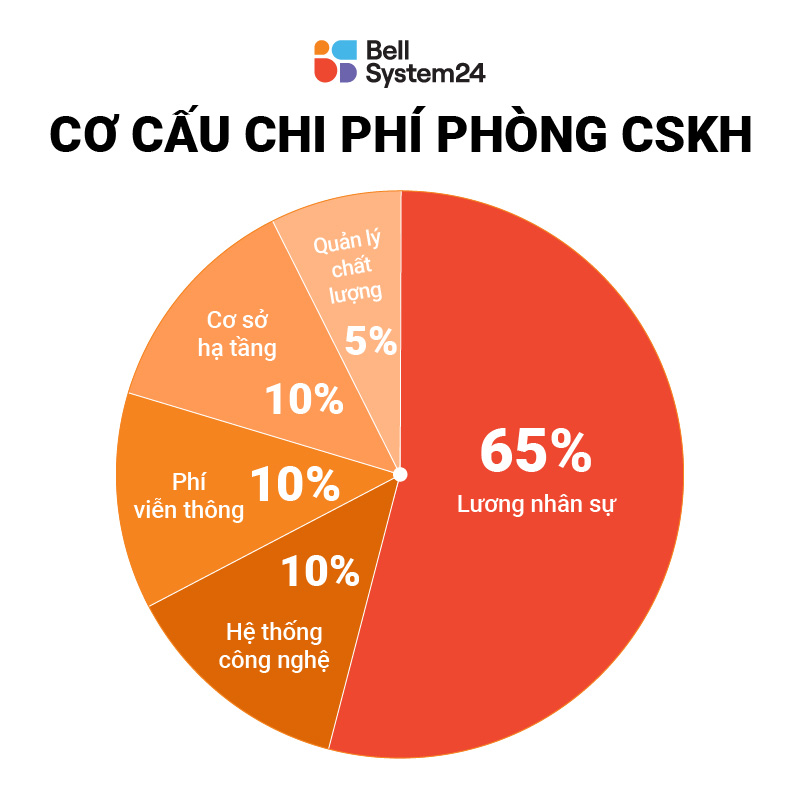
Typically, personnel costs account for the largest proportion, ranging from 60-70% of total operating costs. This figure is not random but reflects the labor-intensive nature of the customer service industry.
However, not every business has the budget and capacity to maintain an in-house call center. In that case, businesses can choose outsourcing—a cost-effective shortcut that also improves quality. Outsourcing helps:
- No initial investment costs for infrastructure, technology.
- Professional human resources approach has been formally trained.
- Flexible scale: easily expandable or scalable according to market demand.
Trends in Contact Center Development
AI supports agents but does not replace humans
In the coming years, Contact Centers are being reshaped through the convergence of advanced AI technology. A report from Zoom predicts that by the end of 2025, up to 80% of customer service and support organizations will use Generative AI to improve customer experience and enhance agent productivity. According to Gartner, personnel costs—which account for 95% of Contact Center operating expenses—will decrease significantly thanks to AI-powered interaction solutions, with projected savings of up to $80 billion by 2026.
However, most businesses implementing Contact Centers confirm that they use AI to automatically take notes, summarize call content, analyze customer data, and suggest appropriate responses. This helps agents save an average of 30–40 minutes of manual processing time, giving them more time to focus on direct communication and resolving complex customer issues. This is also confirmed in a report by the XM Institute, which points out that customers whose issues are resolved on the first call are 1.9 times more likely to purchase additional products and 2.1 times more likely to recommend the brand. This is clear evidence that the "human" element in Contact Centers remains central, while AI serves as a "launchpad" to help employees serve customers more effectively.
Cloud Contact Center, Remote Agents, and Location-based service
Cloud Contact Center and Remote Agents have been highly effective Contact Center operating methods for businesses during the Covid period, and promise to continue to be useful solutions in the future, helping businesses save on labor costs and increase internal flexibility. With Cloud Contact Center and Remote Agents, managers can still monitor the effectiveness and manage their teams. Customer agents will also enjoy faster, more convenient interactions and a better experience. For example, customers calling in can be automatically connected to a remote agent located just a few miles away, allowing the agent to meet with the customer immediately if necessary or understand the geographic location to better assist the customer.
See also: Forecasting Contact Center trends in the next 10 years



